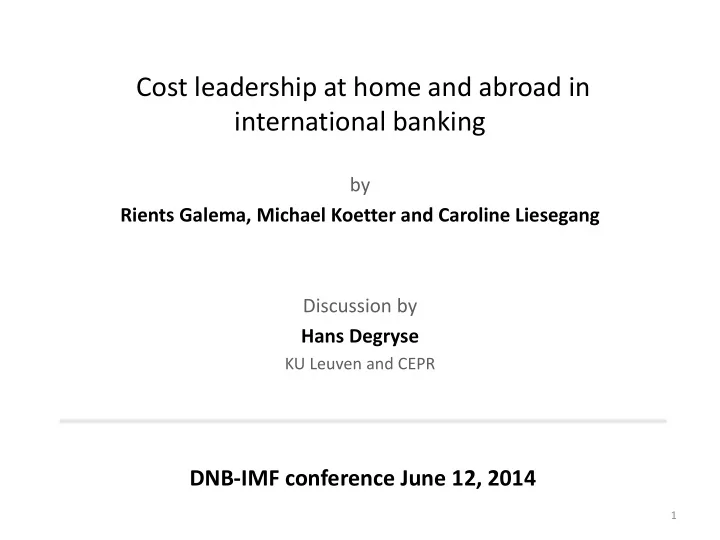

Cost leadership at home and abroad in international banking by Rients Galema, Michael Koetter and Caroline Liesegang Discussion by Hans Degryse KU Leuven and CEPR DNB-IMF conference June 12, 2014 1
Issue • Foreign banks are important players in several banking markets 2
Issue • Relative importance of foreign banks in several banking markets (source: Claessens and van Horen (JMCB2014) • Why: Cost leadership at home? Cost leadership abroad? Bank characteristics? Differences in regulation? Differences 3 in bailout expectations?
Comments (1) • How does Germany compare relative to other countries? 4
Comments (2) • How does Germany compare to rest of world? Are drivers similar or different? • Produce similar stats for Germany and different banking groups 5
Findings and Contribution • Employing an “ international trade ” approach and using a unique micro data set on German banks ’ cross-border activities, the authors show that the likelihood of operating in a host country is larger when • The bank has a domestic cost advantage • The bank has a foreign cost advantage • The bank is less profitable , more risky and larger • The host country attracts more German FDI • The host country imposes less activity restrictions • These associations are less strong for branches than for subsidiaries 6
Comments (3) • Entry barriers may play a role: why not use the Barth et al. time series information on entry barriers? • Subsidiaries versus branches: Dell’Ariccia and Marquez (JF2010) – Economic risk leads to use of subsidiaries – Expropriation risk leads to use of branches – Greater correlation among economic risks reduces the differences between branches and subsidiaries 7
Comments (4) • Difference in “Banking Structure” and “regulation of home and host banking system” may trigger likelihood and depth of foreign banking • Degree of “ overbankedness ” : difference between German overbankedness and host-country overbankedness • Banking assets in Germany around 300% of GDP (compared to about 200% for high income countries (Barth et al (2001,2013) • Difference in regulation may determine likelihood and depth of foreign banking (see e.g. Popov, Ongena and Udell (JFE2013) • Banks’ business models: • Theoretical and empirical model starts from “financial intermediation ” with a bank being active on both sides of the balance sheet • Other business models • Follow the customer (Berger et al. (2003) (you capture this by German FDI) • Only attracting savings (e.g., ING Direct, Icelandic banks) 8
Comments (5) • Multinational banks may “diversify” or “increase risk taking” – could add a business cycle synchronicity indicator • Relates to literature on whether multinational banks increase or decrease business cycles (Morgan, Rime and Strahan (QJE2004; Kalemli-Ozcan et al (JF2013) • Increase stemming from more integration as productivity shocks imply capital may flow from slumping economy to booming economies • Decreasing as it dampens bank loan supply shocks • More synchronicity should remove differences between branches and subsidiaries (Dell’Ariccia and Marquez JF2010 ) • Predictions on differences of coefficients between subsidiaries and branches 9
Comments (6) • Marginal costs are estimated from translog cost function – results are (surprisingly?) similar across banking groups in Germany – Role of TBTF in marginal costs and resulting expansion strategy • Coefficients change quite a bit across specs • Static versus dynamic effects • Policy implications 10
Conclusions • Paper addresses an important question: why do banks reach out to other countries? • Our understanding is still limited and this paper highlights some interesting country and bank- specific drivers • How representative is Germany? Can we extend results to other countries? 11
Recommend
More recommend